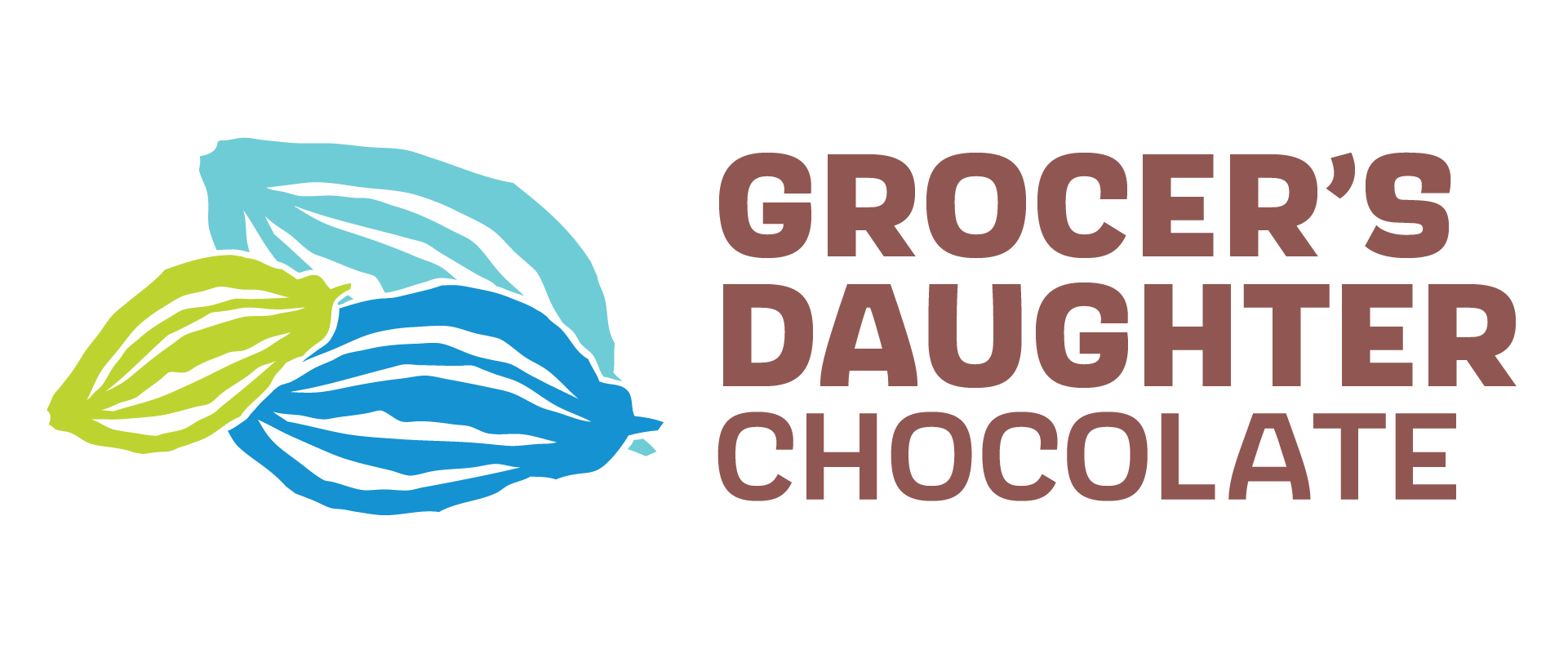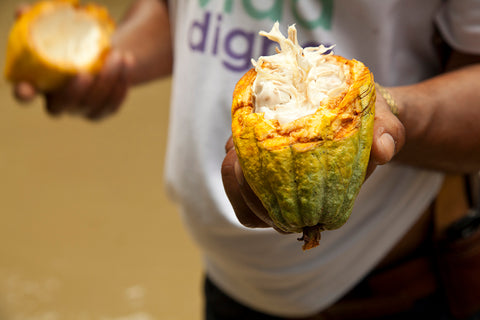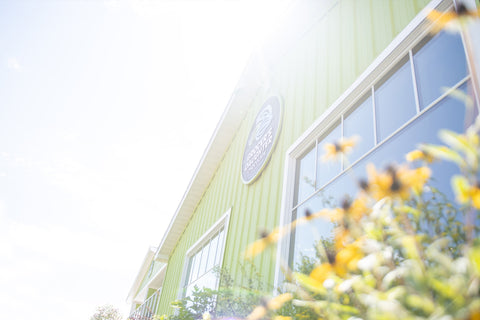
Just like wine or coffee, chocolate expresses a variety of unique flavors depending how the cacao was grown, processed and turned into chocolate. This means tasting chocolate can be a fun adventure - bringing to life the story of the ingredients through unique flavors and textures.
Find out how those flavors are developed and the best way to taste chocolate.
Five Main Factors That Impact Flavor in Chocolate
1. Terrior (French for the “taste of place”)/Microbiology
The microclimate and annual weather patterns where a stand of cacao trees is located impacts the makeup and heath of the soil and the forest canopy. This in turn impacts the quality and flavor of the cacao. From year to year, weather patterns change bringing more or less sun and rain. This can also impact the flavor of cacao just like a tomato grown in the backyard.
2. Harvest
A farmer's attention to detail during harvest can greatly impact cacao quality and therefore flavor. If harvested too soon, unripe cacao beans aren't fully developed, making it difficult to tease out the best flavor. Over-ripe beans can develop mold and fungus that produce defects in the flavor. Harvesting the pods when they are perfectly ripe makes for the best chocolate.
3. Post-Harvest Processing
Cacao is fermented, dried, cleaned and sorted after it's harvested and before it's taken to the factory to become chocolate. This process takes 12-20 days. Fermentation is essential to developing the flavors of the cacao. After fermentation, the beans are sun dried until their moisture content is reduced to 8-10%. Drying cacao in the sun requires careful monitoring so the beans aren’t scorched and maintain the best flavor.
4. Chocolate-making
The cacao is roasted, winnowed and made into liquor (100% refined cacao beans made into a liquid via friction). Once the liquor is made, it is often aged to let flavors develop. Next, chocolate is made by combining liquor, sugar and dairy (for milk chocolate) into a large conch/melangeur that slowly churns the mixture for hours, and sometimes days.
There are many steps in this process that impact flavor. You can roast the same cacao beans in a light roast and a dark roast and have a completely different flavored chocolate. The amount of time the nibs are in the grinder can greatly change the flavor of the liquor. Even the shipment/storage of the chocolate can cause flavor changes.
5. Confection-making
Most chocolate is consumed as bars, confections or hot chocolate. The confectioner has a great deal of power in shaping the end flavor of the chocolate based on their skill at tempering and their choice of recipes, ingredients used in those recipes and other inclusions like nuts, spices, caramel, etc.
What Sets Grocer’s Daughter Chocolate apart?
We’re a little different than most chocolatiers in the country because we source 100% of our chocolate in partnership with Conexion Chocolate, making our entire supply chain transparent and connected. This 'relationship based chocolate' allows us to constantly work to improve the flavor of our chocolate.
As part of this collaboration, we only source chocolate made from Nacional cacao, a rare cacao variety that originated in the Amazon basin, and is known for its delicate fruity, nutty notes and floral aromas. Our cacao comes from four different provinces in Ecuador, each of which produces uniquely flavored chocolate.
In our shop, we go to great lengths to develop recipes and source ingredients that highlight the flavor nuances of the chocolate, not to mask them. We always use local and organic ingredients when we can because we believe they taste better!
How to Taste Chocolate
We completely understand the desire to devour chocolate. But when it comes to tasting the unique flavors, we recommend taking it slow. It’s important to experience the chocolate using many of your senses.
Follow these steps and consider the questions for a thorough chocolate tasting. It’s all about taking the time to determine what you taste.
- Take a close look at the color of the chocolate. Is it deep brown? Or reddish?
- Smell the chocolate. Do you notice any pronounced aromas?
- Try to break a piece of chocolate in your fingers. Is there a clean snap or does it bend?
- Take a small bite with your front teeth and move the chocolate to the center of your tongue. Let it sit there for a few seconds. Start noticing the mouthfeel of the chocolate.
- Push it to the roof of your mouth. Try to feel the particle size. Is the chocolate creamy or coarse? Notice any flavor notes that stand out to you.
- Plug your nose for 3 seconds and release. What aromas rush through your nasal passage?
- Swallow or spit out (sacrilege, right?) the chocolate. Notice the finish; how long it lingers and what flavors come forward.

A Few Fun Tasting Ideas
Try one of these GDC chocolate combinations to create your own chocolate tasting experience at home.
- 70% Dark Chocolate 3 Ways
Tasting Kit: 70% Los Rios, 70% Manabi, and 70% Esmeraldas in bar or nibbling disc form.
This is what we taste in each of these chocolates - do you find the same flavors or are there other things that come to mind?
70% Esmeraldas: Cocoa forward, banana
70% Manabi: Tart berry notes, white flowers, nutty
70% Los Rios (this virgin chocolate is fermented at a lower temperature and flash roasted): Green apple, favorable fermented notes, floral
- Taste Your Way Across the Chocolate Spectrum
Tasting Kit: 100% Baking Bar, 64% Fortaleza dark chocolate bar, 43% milk chocolate bar, 33% White chocolate bar
Taste these chocolates in the order they’re listed above. They will gradually become sweeter then add in a creamy dimension when you reach the milk and white chocolates.
Don’t forget that the percentage is how much of the chocolate is derived from the cacao bean, either the kernel or the fat (cocoa butter). Our 33% white chocolate is likely to taste a lot different than most white chocolate you’ve tried as it has plenty of cocoa butter.
- Truffle Tasting
Tasting Kit: 4 pc box of Mint Truffle, Basil Truffle, Chai Truffle, Ginger Honey Caramel.
Pay special attention to how each flavor develops in your mouth and what the texture feels like on your tongue. We only use natural ingredients to flavor our confections. Do you like the flavors? Would you add more or less of anything? Can you taste/feel the cream (we use high fat local heavy cream for our confections)?
Come See Us to Learn More
If it’s not already painfully obvious, we really love talking about chocolate! If you want to learn more about the flavors experienced in chocolate, come visit our shop in the sweet little town of Empire, Michigan.
Click below to watch Jody lead a quick tasting of our (3) 70% chocolates.





